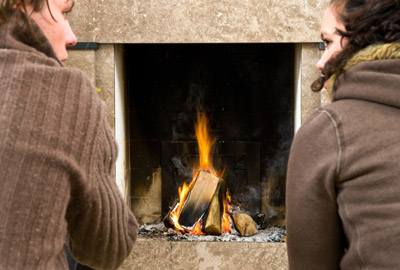
Burning a fire is a peaceful, pleasant way to warm your home. It reduces your consumption of electricity and lowers your utility bills. Not all fireplaces are the same, however.
Depending on your purposes – heating your home, augmenting electrical heat, and so forth – you will want to look at various types of fireplaces to find the most eco-friendly option for your needs.
Here are some types of fireplaces to consider.
Pellet Stoves
These heaters are very clean burning. Few emissions are produced and the pellets themselves are made from waste materials. This gives them a definite environmental advantage. Also, you don’t need a chimney to burn pellets in a pellet
fireplace.
However, pellet stoves are not permissible in some dwellings such as mobile homes, so you’ll need to make sure you can have one if it’s what you’d like to install. Also, pellet stoves do require electricity to run and the initial purchase of the heater can be expensive. You have to buy the pellets, too – unlike wood-burning stoves, free fuel is not to be had.
Wood-burning Fireplaces
Wood-burning fireplaces do have a certain natural, woodsy appeal. And the fuel, wood logs, is renewable. Sometimes you can even come by firewood for free, such as from a neighbor who is cutting down a tree or if a tree falls in your neighborhood and needs to be cut up and hauled away. No electricity is required to burn wood, although an electric blower (which uses much less electricity than central electric heat) can greatly augment your wood-burning fireplace’s heating capabilities.
Wood-burning fireplaces are messy, though, and the smoke produced is cause for environmental concern. And more than just smoke comes out the chimney – heat escapes, too, especially if you use an open fireplace rather than a wood-burning insert. Also, wood-burning fireplaces produce copious amounts of ash which has to be disposed of responsibly (our ancestors made lye soap from wood ash).
Electric Fireplaces
These types of fireplaces are not very expensive, especially compared to the other options, and they are convenient and
portable. There are no real flames, adding to the safety of this type of fireplace. Essentially, they are a glorified space
heater.
Electric fireplaces do, obviously, use electricity. While they do not use nearly what a central heating system uses, they are
still greater consumers of electrical energy than the other types of fireplaces.
Gas
With a real flame but without the hassle of hauling, stacking, and burning wood, gas fireplaces offer much of the ambience of wood burning without the inconvenience. There are even models of gas fireplaces that do not use a chimney, conserving heat within the home and reducing the amount of heat released into the atmosphere.
Carbon monoxide is a concern, particularly with regard to the unvented or chimney-less models. And of course, you’ll need a supply of natural gas to make the flame.

